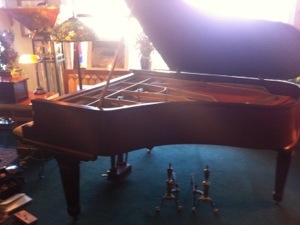What do you look for when looking a used pianos? Often problems that don’t seem that big are major problems and vice versa. Keys that don’t play are usually not a big problem. Often something has broken or come unglued which is easily fixed. There are a few older pianos with old plastic action parts that are problematic.
Look for notes that sound terribly out of tune when played by themselves. Most of the piano has three strings per note. The strings wrap around a steel tuning pin which is set into a wooden pinblock. When the pinblock goes bad it can’t hold the tuning pins tightly and a tuning pin will slip. This leaves one of the three strings very flat to the others. This is not just an out of tune honkey-tonk sound but like it is playing two distinct notes. A bad pinblock may very well be the end of that piano if it is not a good enough piano to warrant rebuilding. There are some stop gap repairs for loose tuning pins. They can be replaced with oversized tuning pins. As a last ditch effort to keep it going a little longer there are chemicals that can be applied that soak into the block and swell it up for a while. Doing this precludes replacing with oversized pins. For a piano you already own this might be a way to keep it going but it is inadvisable to buy a piano with loose tuning pins.
On a high quality piano such as a Steinway, Baldwin, or Mason & Hamlin it may be worth doing a major rebuilding and replace the pinblock. This kind of work costs $20,000-25,000 for a complete rebuild including a new soundboard. But these pianos are considerably more expensive than that new and would therefore warrant the work.
Another serious problem is the presence of strange rattles or buzzes. The soundboard, which is the large wooden board you can see from the back of an upright piano or from underneath a grand, has ribs glued on it to strengthen it. Sometimes when the soundboard gets cracks in it the ribs come unglued from it in places. This can allow the soundboard to rattle against the loose rib as it vibrates. This can sound like a speaker distorting when it is played to loudly. Pianos have a wooden bridge which is attached to the soundboard and has the strings running over it. The bridges have two pins for each string to hold the strings in place. Because there are so many pins very close together, sometimes the bridges split and allow the pins to become loose. This allows the strings to rattle against the loose pins. Bridges are often made in sections that can come unglued from each other also causing buzzes and rattles. See this post showing a split bridge
Look at the hammers for deep grooves cause by the strings. Layers of felt can be removed to restore the rounded shape to the hammer but eventually there in not enough felt left above the wooden molding to get a good tone. The high treble has the least amount of felt and you can sometimes see that the felt is all the way worn through and that the wood molding is actually striking the strings. Hammer replacement is fairly expensive and the piano needs to be good quality to warrant this work. You can’t just replace the felt on the hammers. The felt is put on the moldings in special presses under tons of pressure.
Most important is to call a qualified technician to look at it before you buy it. You should look at the piano first and be sure it is something you are interested in. Then Ron can inspect the piano to check out the structural condition of the piano. An investment of a service call before buying it can keep you from buying and moving a piano that won’t be playable.

